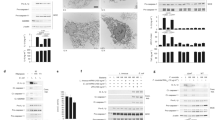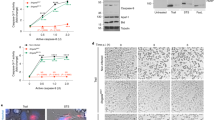Abstract
Lipopolysaccharide (LPS), which is produced by Gram-negative bacteria, is a powerful activator of innate immune responses. LPS binds to the proteins Toll-like receptor 4 (TLR4) and MD2 to activate pro-inflammatory signalling pathways. The TLR4–MD2 receptor complex is crucial for the host recognition of Gram-negative bacterial infection, and pathogens have devised many strategies to evade or manipulate TLR4–MD2 activity. The TLR4–MD2 signalling pathway is therefore potentially an important therapeutic target. This Progress article focuses on recent exciting data that have revealed the structural basis of TLR4–MD2 recognition of LPS.
This is a preview of subscription content, access via your institution
Access options
Subscribe to this journal
Receive 12 print issues and online access
$209.00 per year
only $17.42 per issue
Buy this article
- Purchase on Springer Link
- Instant access to full article PDF
Prices may be subject to local taxes which are calculated during checkout



Similar content being viewed by others
References
Raetz, C. R. & Whitfield, C. Lipopolysaccharide endotoxins. Annu. Rev. Biochem. 71, 635–700 (2002).
Golenbock, D. T., Hampton, R. Y., Qureshi, N., Takayama, K. & Raetz, C. R. Lipid A-like molecules that antagonize the effects of endotoxins on human monocytes. J. Biol. Chem. 266, 19490–19498 (1991).
Walsh, C. et al. Elucidation of the MD-2/TLR4 interface required for signaling by lipid IVa. J. Immunol. 181, 1245–1254 (2008).
Lohmann, K. L., Vandenplas, M., Barton, M. H. & Moore, J. N. Lipopolysaccharide from Rhodobacter sphaeroides is an agonist in equine cells. J. Endotoxin Res. 9, 33–37 (2003).
Christ, W. J. et al. E5531, a pure endotoxin antagonist of high potency. Science 268, 80–83 (1995).
Figueiredo, M. D., Moore, J. N., Vandenplas, M. L., Sun, W. C. & Murray, T. F. Effects of the second-generation synthetic lipid A analogue E5564 on responses to endotoxin in [corrected] equine whole blood and monocytes. Am. J. Vet. Res. 69, 796–803 (2008).
Stover, A. G. et al. Structure-activity relationship of synthetic Toll-like receptor 4 agonists. J. Biol. Chem. 279, 4440–4449 (2004).
Teghanemt, A., Zhang, D., Levis, E. N., Weiss, J. P. & Gioannini, T. L. Molecular basis of reduced potency of underacylated endotoxins. J. Immunol. 175, 4669–4676 (2005).
Mata-Haro, V. et al. The vaccine adjuvant monophosphoryl lipid A as a TRIF-biased agonist of TLR4. Science 316, 1628–1632 (2007).
Darveau, R. P. et al. Porphyromonas gingivalis lipopolysaccharide contains multiple lipid A species that functionally interact with both Toll-like receptors 2 and 4. Infect. Immun. 72, 5041–5051 (2004).
Janeway, C. A. Jr. Approaching the asymptote? Evolution and revolution in immunology. Cold Spring Harb. Symp. Quant. Biol. 54, 1–13 (1989).
Schumann, R. R. et al. Structure and function of lipopolysaccharide binding protein. Science 249, 1429–1431 (1990).
Wright, S. D., Ramos, R. A., Tobias, P. S., Ulevitch, R. J. & Mathison, J. C. CD14, a receptor for complexes of lipopolysaccharide (LPS) and LPS binding protein. Science 249, 1431–1433 (1990).
Gioannini, T. L. et al. Isolation of an endotoxin–MD-2 complex that produces Toll-like receptor 4-dependent cell activation at picomolar concentrations. Proc. Natl Acad. Sci. USA 101, 4186–4191 (2004).
Haziot, A. et al. Resistance to endotoxin shock and reduced dissemination of Gram-negative bacteria in CD14-deficient mice. Immunity 4, 407–414 (1996).
Medzhitov, R., Preston-Hurlburt, P. & Janeway, C. A. Jr. A human homologue of the Drosophila Toll protein signals activation of adaptive immunity. Nature 388, 394–397 (1997).
Poltorak, A. et al. Defective LPS signaling in C3H/HeJ and C57BL/10ScCr mice: mutations in Tlr4 gene. Science 282, 2085–2088 (1998).
Qureshi, S. T. et al. Endotoxin-tolerant mice have mutations in Toll-like receptor 4 (Tlr4). J. Exp. Med. 189, 615–625 (1999).
Akira, S., Uematsu, S. & Takeuchi, O. Pathogen recognition and innate immunity. Cell 124, 783–801 (2006).
Arbour, N. C. et al. TLR4 mutations are associated with endotoxin hyporesponsiveness in humans. Nature Genet. 25, 187–191 (2000).
Shimazu, R. et al. MD-2, a molecule that confers lipopolysaccharide responsiveness on Toll-like receptor 4. J. Exp. Med. 189, 1777–1782 (1999).
Nagai, Y. et al. Essential role of MD-2 in LPS responsiveness and TLR4 distribution. Nature Immunol. 3, 667–672 (2002).
Gay, N. J. & Gangloff, M. Structure of Toll-like receptors. Handb. Exp. Pharmacol. 183, 181–200 (2008).
Gay, N. J., Gangloff, M. & Weber, A. N. Toll-like receptors as molecular switches. Nature Rev. Immunol. 6, 693–698 (2006).
Inohara, N. & Nunez, G. ML — a conserved domain involved in innate immunity and lipid metabolism. Trends Biochem. Sci. 27, 219–221 (2002).
Gangloff, M. & Gay, N. J. MD-2: the Toll 'gatekeeper' in endotoxin signalling. Trends Biochem. Sci. 29, 294–300 (2004).
Gruber, A., Mancek, M., Wagner, H., Kirschning, C. J. & Jerala, R. Structural model of MD-2 and functional role of its basic amino acid clusters involved in cellular lipopolysaccharide recognition. J. Biol. Chem. 279, 28475–28482 (2004).
Ohto, U., Fukase, K., Miyake, K. & Satow, Y. Crystal structures of human MD-2 and its complex with antiendotoxic lipid IVa. Science 316, 1632–1634 (2007).
Kim, H. M. et al. Crystal structure of the TLR4-MD-2 complex with bound endotoxin antagonist Eritoran. Cell 130, 906–917 (2007).
Jin, M. S. & Lee, J. O. Structures of the Toll-like receptor family and its ligand complexes. Immunity 29, 182–191 (2008).
Liu, L. et al. Structural basis of Toll-like receptor 3 signaling with double-stranded RNA. Science 320, 379–381 (2008).
Jin, M. S. et al. Crystal structure of the TLR1-TLR2 heterodimer induced by binding of a tri-acylated lipopeptide. Cell 130, 1071–1082 (2007).
Nu, A. R. et al. Essential roles of hydrophobic residues in both MD-2 and Toll-like receptor 4 in activation by endotoxin. J. Biol. Chem. 284, 15052–15060 (2009).
Park, B. S. et al. The structural basis of lipopolysaccharide recognition by the TLR4–MD2 complex. Nature 458, 1191–1195 (2009).
Rallabhandi, P. et al. Analysis of TLR4 polymorphic variants: new insights into TLR4/MD-2/CD14 stoichiometry, structure, and signaling. J. Immunol. 177, 322–332 (2006).
Gay, N. J. & Gangloff, M. Structure and function of Toll receptors and their ligands. Annu. Rev. Biochem. 76, 141–165 (2007).
Okamura, Y. et al. The extra domain A of fibronectin activates Toll-like receptor 4. J. Biol. Chem. 276, 10229–10233 (2001).
Trompette, A. et al. Allergenicity resulting from functional mimicry of a Toll-like receptor complex protein. Nature 457, 585–588 (2009).
Saitoh, S. et al. Lipid A antagonist, lipid IVa, is distinct from lipid A in interaction with Toll-like receptor 4 (TLR4)-MD-2 and ligand-induced TLR4 oligomerization. Int. Immunol. 16, 961–969 (2004).
Lorenz, E., Mira, J. P., Frees, K. L. & Schwartz, D. A. Relevance of mutations in the TLR4 receptor in patients with Gram-negative septic shock. Arch. Intern. Med. 162, 1028–1032 (2002).
O'Neill, L. A. & Bowie, A. G. The family of five: TIR-domain-containing adaptors in Toll-like receptor signalling. Nature Rev. Immunol. 7, 353–364 (2007).
Nunez Miguel, R. et al. A dimer of the Toll-like receptor 4 cytoplasmic domain provides a specific scaffold for the recruitment of signalling adaptor proteins. PLoS ONE 2, e788 (2007).
Toshchakov, V. Y. & Vogel, S. N. Cell-penetrating TIR BB loop decoy peptides a novel class of TLR signaling inhibitors and a tool to study topology of TIR–TIR interactions. Expert Opin. Biol. Ther. 7, 1035–1050 (2007).
Mansell, A. et al. Suppressor of cytokine signaling 1 negatively regulates Toll-like receptor signaling by mediating Mal degradation. Nature Immunol. 7, 148–155 (2006).
Kagan, J. C. & Medzhitov, R. Phosphoinositide-mediated adaptor recruitment controls Toll-like receptor signaling. Cell 125, 943–955 (2006).
Rowe, D. C. et al. The myristoylation of TRIF-related adaptor molecule is essential for Toll-like receptor 4 signal transduction. Proc. Natl Acad. Sci. USA 103, 6299–6304 (2006).
McGettrick, A. F. et al. Trif-related adapter molecule is phosphorylated by PKCɛ during Toll-like receptor 4 signaling. Proc. Natl Acad. Sci. USA 103, 9196–9201 (2006).
Tanimura, N., Saitoh, S., Matsumoto, F., Akashi-Takamura, S. & Miyake, K. Roles for LPS-dependent interaction and relocation of TLR4 and TRAM in TRIF-signaling. Biochem. Biophys. Res. Commun. 368, 94–99 (2008).
Miller, S. I., Ernst, R. K. & Bader, M. W. LPS, TLR4 and infectious disease diversity. Nature Rev. Microbiol. 3, 36–46 (2005).
Montminy, S. W. et al. Virulence factors of Yersinia pestis are overcome by a strong lipopolysaccharide response. Nature Immunol. 7, 1066–1073 (2006).
Munford, R. S. Sensing Gram-negative bacterial lipopolysaccharides: a human disease determinant? Infect. Immun. 76, 454–465 (2008).
Thomas, G. L. et al. Immunomodulatory effects of Pseudomonas aeruginosa quorum sensing small molecule probes on mammalian macrophages. Mol. Biosyst. 2, 132–137 (2006).
Hammad, H. et al. House dust mite allergen induces asthma via Toll-like receptor 4 triggering of airway structural cells. Nature Med. 15, 410–416 (2009).
Melendez, A. J. et al. Inhibition of FcɛRI-mediated mast cell responses by ES-62, a product of parasitic filarial nematodes. Nature Med. 13, 1375–1381 (2007).
Newman, R. M., Salunkhe, P., Godzik, A. & Reed, J. C. Identification and characterization of a novel bacterial virulence factor that shares homology with mammalian Toll/interleukin-1 receptor family proteins. Infect. Immun. 74, 594–601 (2006).
Low, L. Y., Mukasa, T., Reed, J. C. & Pascual, J. Characterization of a TIR-like protein from Paracoccus denitrificans. Biochem. Biophys. Res. Commun. 356, 481–486 (2007).
Cirl, C. et al. Subversion of Toll-like receptor signaling by a unique family of bacterial Toll/interleukin-1 receptor domain-containing proteins. Nature Med. 14, 399–406 (2008).
Radhakrishnan, G. K., Yu, Q., Harms, J. S. & Splitter, G. A. Brucella TIR domain-containing protein mimics properties of the toll-like receptor adaptor protein TIRAP. J. Biol. Chem. 284, 9892–9898 (2009).
Lee, H. K., Brown, S. J., Rosen, H. & Tobias, P. S. Application of β-lactamase enzyme complementation to the high-throughput screening of Toll-like receptor signaling inhibitors. Mol. Pharmacol. 72, 868–875 (2007).
Toshchakov, V. Y., Fenton, M. J. & Vogel, S. N. Cutting edge: differential inhibition of TLR signaling pathways by cell-permeable peptides representing BB loops of TLRs. J. Immunol. 178, 2655–2660 (2007).
Kawamoto, T., Ii, M., Kitazaki, T., Iizawa, Y. & Kimura, H. TAK-242 selectively suppresses Toll-like receptor 4-signaling mediated by the intracellular domain. Eur. J. Pharmacol. 584, 40–48 (2008).
O'Brien, A. D. et al. Genetic control of susceptibility to Salmonella typhimurium in mice: role of the LPS gene. J. Immunol. 124, 20–24 (1980).
Mullarkey, M. et al. Inhibition of endotoxin response by E5564, a novel Toll-like receptor 4-directed endotoxin antagonist. J. Pharmacol. Exp. Ther. 304, 1093–1102 (2003).
Tidswell, M. et al. Phase 2 trial of Eritoran tetrasodium (E5564), a Toll-like receptor 4 antagonist, in patients with severe sepsis. Crit. Care Med. 5 August 2009 [epub ahead of print].
Roger, T. et al. Protection from lethal Gram-negative bacterial sepsis by targeting Toll-like receptor 4. Proc. Natl Acad. Sci. USA 106, 2348–2352 (2009).
Neubig, R. R., Spedding, M., Kenakin, T. & Christopoulos, A. International Union of Pharmacology Committee on Receptor Nomenclature and Drug Classification. XXXVIII. Update on terms and symbols in quantitative pharmacology. Pharmacol. Rev. 55, 597–606 (2003).
Acknowledgements
We would like to thank the Medical Research Council, the Biotechnology and Biological Sciences Research Council, the Wellcome Trust and the Horserace Betting Levy Board for funding our work. We apologise to those authors whose work we were unable to cite owing to space constraints.
Author information
Authors and Affiliations
Corresponding author
Supplementary information
Supplementary information S1 (figure)
The structures of lipid A from different bacterial species and the structures of synthetic lipid A analogues. (PDF 175 kb)
Related links
Related links
DATABASES
Entrez Genome
Entrez Genome Project
Salmonella enterica subsp. enterica serovar Enteritidis
Protein Data Bank
FURTHER INFORMATION
Rights and permissions
About this article
Cite this article
Bryant, C., Spring, D., Gangloff, M. et al. The molecular basis of the host response to lipopolysaccharide. Nat Rev Microbiol 8, 8–14 (2010). https://doi.org/10.1038/nrmicro2266
Published:
Issue Date:
DOI: https://doi.org/10.1038/nrmicro2266
This article is cited by
-
Vivaria housing conditions expose sex differences in brain oxidation, microglial activation, and immune system states in aged hAPOE4 mice
Experimental Brain Research (2024)
-
Effects of the drying method and extraction solvent on antioxidant and anti-inflammatory activity of Melosira nummuloides bioproducts
Applied Biological Chemistry (2023)
-
Butterflies in the gut: the interplay between intestinal microbiota and stress
Journal of Biomedical Science (2023)
-
Deletion of Gpatch2 does not alter Tnf expression in mice
Cell Death & Disease (2023)
-
Evaluation of benzoylacetonitriles as novel anti-neuroinflammatory agents
Medicinal Chemistry Research (2023)



